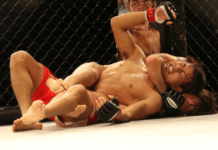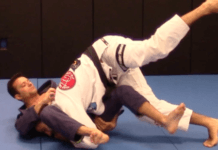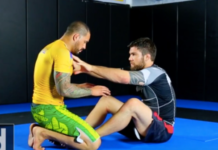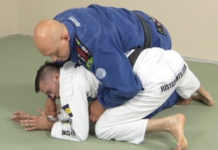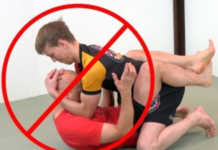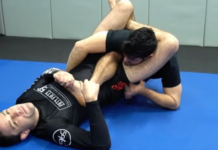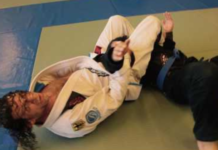The crucifix is a rather unorthodox position in BJJ. Not a lot of people perform it – you can usually see it performed by some of the higher belts – purple belts and above. But this doesn’t mean that you can’t experiment with the crucifix as even a white belt. The fact of the matter is that things may not work out for you as easily and as smoothly as a white belt. You still need to drill your basic techniques and BJJ body movements before you’ll be able to do the somewhat advanced crucifix position. However, you’re free to give it a try. Below you will find out some more information about how you can enter the crucifix position and how you can maintain it.
Crucifix Set Up
If you’re a white belt, then you might find it hard to enter this position. One of the main ways in which you can do this is when your opponent is in the turtle position. You need to then come at his side with your body and grab his opposite wrist with the motorcycle grip. What you then need to do is put your need between your opponent’s knee and his elbow. This may take some time if your opponent defends this space – but you can still find ways to enter the area.
Then you need to put your foot over your opponent’s arm so that it will touch your knee at the same side. And then all you need to do is fall down to the side while pulling your opponent with you. You need to close off your opponent’s arm with your legs and keep a hold on his wrist with your hand.
We understand if this seems a bit difficult to see in your mind’s eye and this is why we’ll provide you with a video tutorial on how you can enter the position. You can see the video of the demonstration below.
You can get into the crucifix if you take your opponent’s back as well. You need to twist your body to the side and use your legs to lock your opponent’s arm while still keeping a firm motorcycle grip on his other arm. This way may be easier for some of you to do. Try it out and see for yourself.
Attacks from the Crucifix
The crucifix is a great position because it gives you a big degree of control over your opponent. You will be able to perform a lot of attacking moves while your opponent will be almost completely immobilized. So, it goes without saying that if you manage to get into this position, then you will be able to do some damage.
The first thing that you will realize once you get in this position is that your opponent’s neck will be very vulnerable. If your opponent’s wearing a gi, then you will be able to a simple cross-collar choke. This is one of the simplest and most basic chokes in the entire BJJ arsenal. If your opponent isn’t wearing a gi, then you can always go for the classic rear naked choke. You’ll see that these two chokes are a lot easier to perform than from some of the other positions.
Also, if you maneuver your legs in a proper, ingenious way, you will be able to do a kimura on your opponent’s shoulder – but with your legs. You will need to follow a strict setup in order to be able to perform this move. You need to inject your leg between your opponent’s bicep and forearm – like you would do a bicep slicer. Then you need to grab your opponent’s wrist and put your other leg over it. Now you will be able to scoot backward and commence the move. If you wish to see a visual demonstration of how this is made, then we suggest that you see Stephan Kesting’s informative video at
Crucifix Escape and defense
The fact of the matter is that if your opponent is skilled enough, then it will be very difficult for you to get out of the crucifix. What you can hope to do is find some loopholes in the technique that your opponent uses in order to wiggle out your arm and escape. But if the crucifix is set firmly into place with all the details that are required – then it may be next to impossible for you to get out. And this is the main reason as to why you would want to be mindful of not getting caught in the crucifix in the first place.
In conclusion
The crucifix is definitely a technique that we recommend to the above-white belts only. It will be difficult to implement this move as a white belt. But you shouldn’t be afraid to try it out no matter what level you’re at with your BJJ skills. This move is generally safe to perform – barring any excessive, explosive movement that may dislocate your opponent’s shoulder or elbow.
Check also:
- Electric Chair – Eddie Bravo’s Sweep and Submission
- Banana Split Submission for BJJ and MMA
- North-South Choke – Execution and Defense
- Estima lock – Devastatingly Effective Leg Lock

